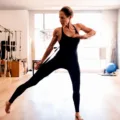The Benefits of Pilates for Seniors
As we age, our bodies change. Joints become stiffer, muscles lose flexibility, and balance diminishes. For senior runners, these changes can make maintaining an enjoyable running routine more challenging.
That’s where Pilates can help. This low-impact exercise focuses on building core strength, stability, and flexibility – precisely what older runners need. Let’s explore the benefits of Pilates for seniors looking to support their running.
Increasing Flexibility and Range of Motion
Many Pilates exercises incorporate controlled motions that gently increase flexibility. Forward folds, lateral bends, and rotational movements enhance range of motion throughout the body over time.
For runners, improved flexibility translates into a longer stride and more efficient form. It also allows muscles and joints to move freely through their full range – crucial for injury prevention.
Building Core Stability
Running works the core muscles, but it strengthens primarily the rectus abdominis. For comprehensive core fitness, the obliques, transverse abdominis, pelvic floor, lower back, and glutes must also be engaged.
Pilates targets all these areas. By training core muscles to activate together, Pilates improves posture, balance, and stability – essential for preventing falls on uneven terrain.
Strengthening the Lower Body
Running strengthens the lower body but often creates muscle imbalances over time. Common weak spots include the inner thighs, glutes, and deep core.
Pilates evens out these imbalances. Lower body exercises reinforce hip stability, realign the pelvis, and teach full recruitment of the glutes – correcting form, enhancing performance, and reducing injury risk.
Cultivating Body Awareness
As we age, nerves lose sensitivity, dulling mind-body connection. Many seniors struggle to activate muscles or detect poor alignment.
Pilates trains body awareness. Concentrating on breath and precise movements heightens neuromuscular connections. Over time, practitioners learn to move from their core – promoting balance, posture, and efficient biomechanics.
Providing Low-Impact Cross-Training
Running’s repetitive impact can overwhelm aging tissues. Pilates offers intense but gentle resistance training – perfect for recovery days or cross-training.
Isometric and eccentric exercises build strength without trauma or wear. Stretches realign connective tissue between run sessions. Such self-care sustains running health long-term.
FAQ
What are some beginner Pilates exercises for runners?
Good starter exercises include shoulder rolls, knee lifts, and spine stretches. Work on flexing the feet and engaging pelvic floor muscles too. Simple moves that strengthen core stability pave the way for more advanced training.
How often should runners do Pilates?
Aim for two to three Pilates sessions per week alongside your running routine. Consistency is key – even 20-30 minutes twice a week can improve strength and flexibility within a couple months.
How soon before running should I do Pilates?
Pilates is great cross-training on recovery run days. If you choose to Pilates before running, allow 12-24 hours for your body to integrate the exercises neuromuscularly. Proper form prevents injury.
Can Pilates help with common running injuries?
Yes! By stretching connective tissues and balancing strength, Pilates can aid rehabilitation and prevention of runner’s knee, shin splints, pulled muscles, Achilles tendinitis, and more.
Is Pilates better than yoga for runners?
Pilates and yoga both enhance running with flexibility, strength, and breath training. Pilates emphasizes core and alignment. Yoga boosts mobility. For best results, runners should cross-train with both disciplines.









